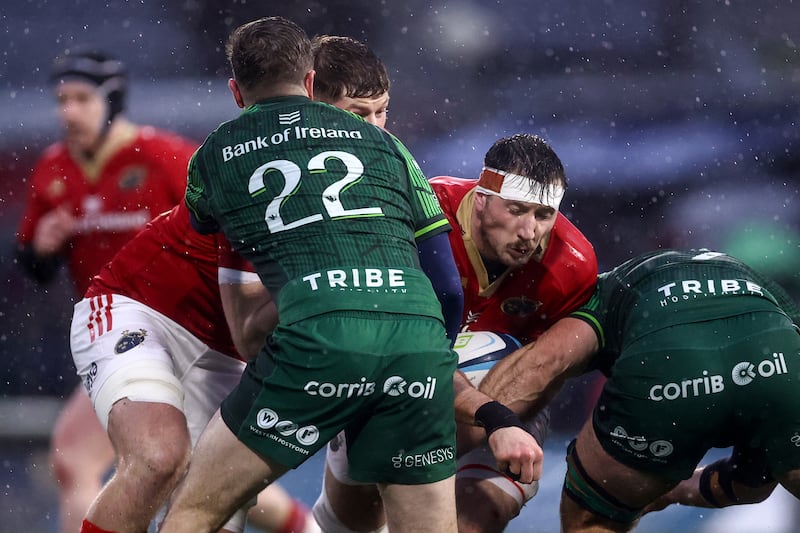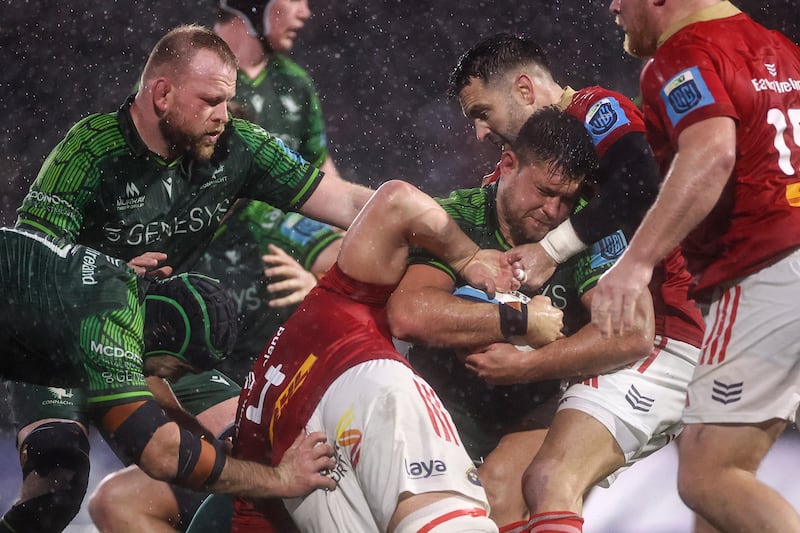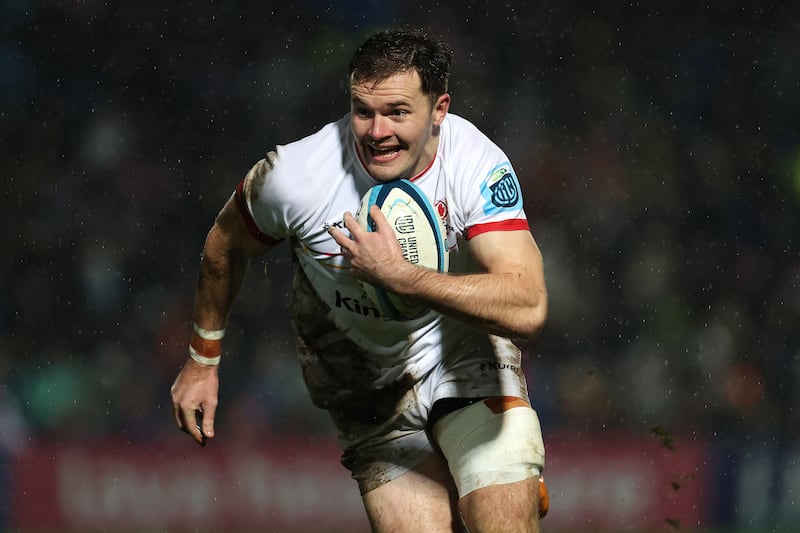“You have to earn the right to go around a team,” is a dog-eared rugby expression with which I was familiar from my earliest playing days in Clongowes, Wexford Wanderers and Lansdowne and throughout my professional career with Leinster and Ireland. It remains a core principle of the sport, one that relies on condensing the opposition’s defence to create space elsewhere.
The advent of 4G pitches offers some mitigation in terms of the reasonably solid underfoot conditions when the weather is at its worst – the old days of having to run in a muddy gluepot are largely gone – but the component parts of the game have to be in good working order, and two of the main tenets are the set piece of scrum and lineout.
This provides a team with the core stability to play. Connacht and Munster had the worst of the elements on Monday afternoon, playing in a gale and driving rain at the Sportsground while Leinster’s game against Ulster at the RDS was more a rain-soaked affair.
Whatever the conditions a team’s set piece has to be reliable, to give them a proper shot at winning. Munster have been trying to operate while shackled by a horrendous injury list in recent weeks one that keeps growing, but putting that to one side for a second, they have still been in a position to win their last four fixtures, against Bayonne and Exeter Chiefs in Europe, and Leinster and Connacht in the URC. The net result has been a draw and three defeats.
READ MORE
A brittle set piece compounded the issues thrown up by the extensive injury list, as debilitating as trying to fight with one hand tied behind your back. Munster, playing with the strong wind in the first half, looked to run the ball rather than seek out space in the backfield through a kicking game, but were too often guilty of being caught going backward and sideways in trying to get the ball wide.
Thomas Ahern, so effective in the wide channels against Exeter, was well marshalled, not given anything like the same scope. There was nothing wrong with Munster’s logic, Connacht needed to cover the backfield and there would have been space out wide to exploit, but getting the ball there places a premium on individual and collective skills.

While outside-centre Antoine Frisch has been consistently excellent as a fulcrum in attack, he alone could not give that aspect of the game the shape that it required. Tony Butler is still finding his way at this level and was never really given a fair chance to settle in Galway. He became a facilitator in a match where Munster needed a bit more from their outhalf.
Conor Murray sporadically found a few holes and had a couple of nice touches to put his side on the front foot or in good field positions, but the move invariably petered out with a handling error or a poor decision.
Sometimes the weather conditions define the gameplan, Munster’s on the day was not conducive to achieving their goal in that respect, and they might instead have borrowed from an old playbook; kick astutely and apply suffocating pressure at set piece and breakdown.
The visitors failed to narrow Connacht’s defence thereby being able to either kick on a dominant footing or effectively get the ball to space in the wider channels. When you contrast this with the home side who opted for a 6-2 split on the bench and played a style that they were more comfortable with, and for me one that suited the weather.
The execution was far from perfect but with a set piece that functioned adequately for the most part, they elected to kick on the front foot to win the territory battle. What they didn’t do was play too much rugby in their own half, and despite two block-downs which could have gone Munster way, Connacht’s kicking strategy and set piece won the day.

Munster have endured a tough time of late, underlined by a brutal injury list, but despite the misfortune Graham Rowntree, his coaches, and players, have to come up with and implement a plan to take into the final two rounds of European pool matches against Toulon away and at home to the English Premiership leaders, the Northampton Saints the following Saturday.
Ulster’s second try against Leinster at the RDS showed a similarity of approach they share with Munster in getting a player to hold width out in the five-metre channel; the primary difference is how they get the ball there.
Ulster were creative, in a similar vein to the way they beat Racing 92, forcing a line break, getting the opposition defence to narrow up, and then getting the ball to the space, thanks to Billy Burns pinpoint kicking game.
The exposed weaknesses in Leinster’s new defensive shape, innovative in how they worked the opportunities, with Burns taking the ball deep, drawing the Leinster defence forward and then taking advantage of the space on the opposite side of the pitch.
Leinster were forewarned when conceding a try to Jacob Stockdale, but they were caught cold again out wide for Nick Timoney’s second try. Two backward passes provided Burns with enough time to execute a pinpoint crossfield kick to his number eight, who slid over.

The template for Leinster’s type of defence is South Africa and is predicated on big men making impact tackles or enough of an impact to slow down the ruck by a second or so, to allow players to realign with the correct spacing to avoid mismatches.
Leinster were guilty of being a little slow to realign correctly from rucks at times. In my experience this usually requires an old head that has been there before to recognise the threat and know when to bypass the collective defence philosophy. There is a slight danger for Leinster that they focus too much on defence and have lost their way a little in attack.
Ulster should be hugely buoyed by this win and need to continue to tap into this new creative approach. It works for them because less structure seems to bring the best out in the wider group.
Leinster will reflect on the performance and know there were plenty of good things and with a bit more composure they could have managed to squeeze out a positive result. There are important lessons to be absorbed and a primary one is the need to be clinically accurate on both sides of the ball and to have the composure and patience to work opportunities to a point where a score is a certainty.
Attack has always been the bedrock of Leinster rugby but there’s no doubt that it is not where it needs to be; the machine is sputtering and requires an oil change. There’s always a balance to be struck in that fine-tuning process but Leinster need more time devising and integrating greater fluency in their attacking patterns.















